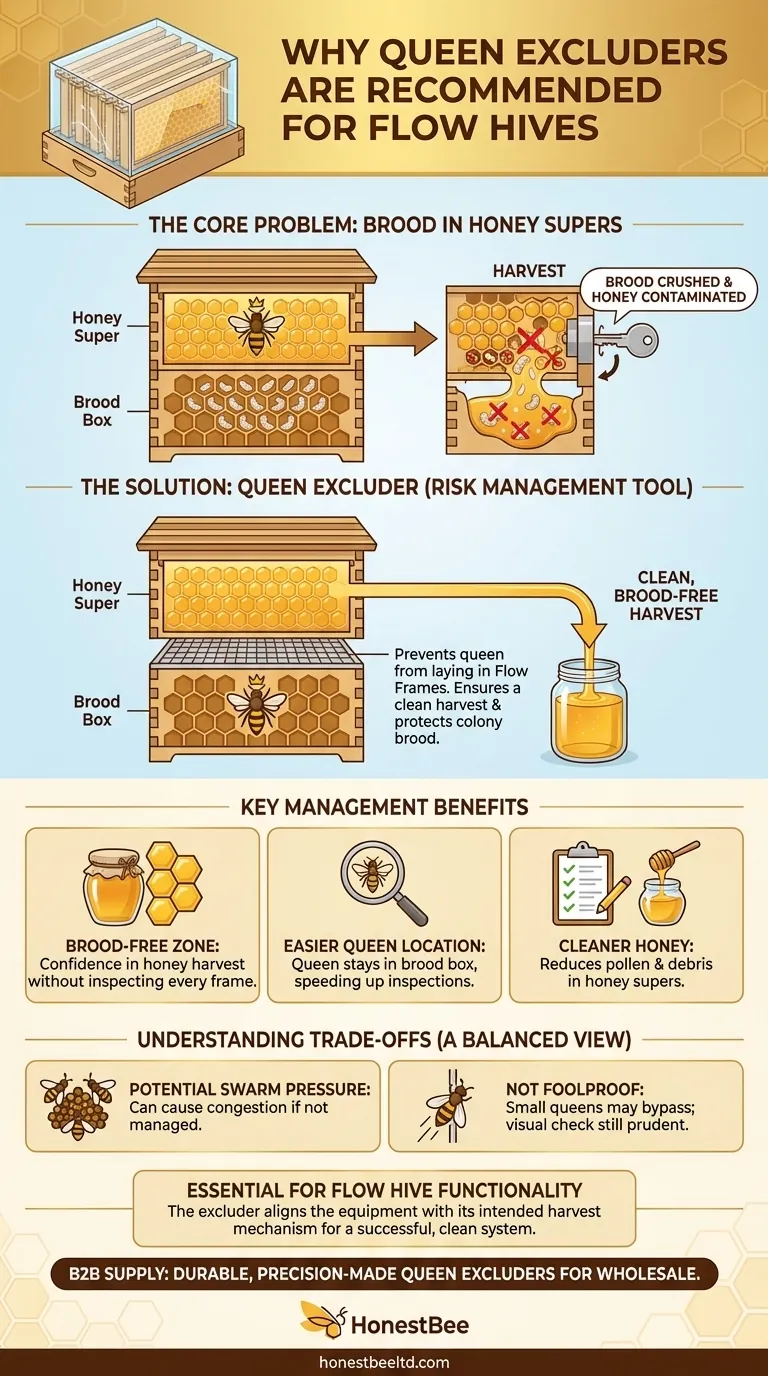At its core, a queen excluder is recommended for a Flow Hive to solve a single, critical problem. It prevents the queen bee from laying eggs in the Flow Frames, which is essential because the unique honey harvesting mechanism of this system would crush any eggs or larvae present in the cells.
The primary function of a queen excluder in a Flow Hive is risk management. It creates a dedicated "honey-only" zone, ensuring a clean harvest and preventing the unintentional destruction of the colony's brood.

The Core Problem: Brood in the Flow Frames
To understand the recommendation, you must first understand the conflict between a queen's natural behavior and the Flow Hive's harvesting technology.
Why the Queen Lays in Honey Supers
A healthy, productive queen is constantly seeking empty cells to lay eggs in to expand the colony's population. Without a barrier, she will readily move upwards from the brood box into the honey super (the Flow Hive box) and fill those cells with eggs.
The Unique Flow Hive Mechanism
Unlike traditional extraction, where combs are spun, the Flow Hive works by splitting the honeycomb cells vertically. A key is turned, creating channels that allow the honey to drain downwards and out of the hive.
The Consequence of No Excluder
If a queen has laid eggs in the Flow Frames, this cell-splitting action will inevitably crush the developing bees (eggs and larvae). This not only contaminates the honey with brood but also destroys a portion of the colony's next generation.
The Queen Excluder as a Management Tool
Beyond preventing a disastrous harvest, the excluder simplifies overall hive management. It enforces a clear boundary between the different functions of the hive.
Ensuring a "Brood-Free Zone"
With an excluder in place, you can harvest honey with confidence, knowing you do not need to pull out and inspect every single Flow Frame for the presence of brood. This aligns perfectly with the Flow Hive's goal of simplified extraction.
Locating the Queen with Ease
The excluder guarantees the queen is in a known location: the brood box below. This dramatically speeds up hive inspections when you need to find her to check her health and laying pattern.
Promoting Cleaner Honey
By keeping brood out of the honey supers, you also reduce the amount of pollen that is typically stored near the brood nest. This can result in a cleaner final honey product.
Understanding the Trade-offs
While highly recommended for the Flow Hive system, queen excluders are a subject of debate in general beekeeping because they are not without potential downsides.
Potential for Increased Swarm Pressure
The excluder creates a physical barrier that can make the brood nest feel congested more quickly. The colony may perceive that it has run out of space, which is a primary trigger for swarming.
Not a Foolproof Barrier
Beekeepers must remember that an excluder is not 100% effective. A particularly small or determined queen can sometimes squeeze through the gaps, so a quick visual check before harvesting is still a prudent step.
A Departure from Natural Design
In some hive designs, like Top Bar Hives, excluders are unnecessary. The bees naturally separate the brood and honey areas. The Flow Hive's vertical Langstroth design does not encourage this separation, making the excluder a necessary management tool to impose that order.
Making the Right Choice for Your Hive
The decision to use a queen excluder with a Flow Hive is less a matter of preference and more a matter of aligning the equipment with its intended function.
- If your primary focus is a simple and clean honey harvest: The queen excluder is an essential component for preventing brood damage and honey contamination.
- If you are a new beekeeper using a Flow Hive: Using the excluder is the safest and most reliable way to ensure a successful harvest without harming your colony.
- If you are an advanced beekeeper experimenting with hive dynamics: You could attempt management without one, but you must accept the high risk and commit to meticulous inspections to keep the queen out of the Flow Super.
By understanding its purpose as a tool for risk prevention, you can manage your Flow Hive with confidence and efficiency.
Summary Table:
| Function | Benefit for Flow Hive |
|---|---|
| Prevents Queen Access | Stops the queen from laying eggs in the Flow Frames, preventing brood from being crushed during harvest. |
| Creates Honey-Only Zone | Ensures a clean, brood-free honey harvest, avoiding contamination. |
| Simplifies Hive Management | Makes it easy to locate the queen and eliminates the need to inspect every frame for brood before harvesting. |
| Risk Management | Protects the colony's next generation and aligns with the Flow Hive's goal of simplified extraction. |
Ensure a successful and clean harvest from your Flow Hive. HONESTBEE supplies durable, precision-made queen excluders and other essential beekeeping supplies to commercial apiaries and distributors through our wholesale-focused operations. Protect your investment and simplify your hive management—contact our experts today to discuss your needs and place an order!
Visual Guide

Related Products
- Professional Plastic Queen Excluder for Modern Beekeeping
- Premium Wood Framed Metal Wire Queen Bee Excluder
- Wooden Queen Bee Excluder for Beekeeping
- Plastic Queen Bee Excluder for Bee Hive Wholesale
- High Performance Plastic Queen Excluder for Beekeeping and Apiary Management
People Also Ask
- How does a queen excluder work? Master Hive Management for Pure Honey Harvests
- What is the role of a queen excluder when adding a super? Ensure Brood-Free Honey Harvests
- What is the purpose of a queen excluder when adding a super? Streamline Your Honey Harvest
- How do queen excluders work in terms of spacing and bee movement? A Guide to Precision Hive Management
- What are the pros of using queen excluders? Boost Honey Production & Hive Efficiency



















